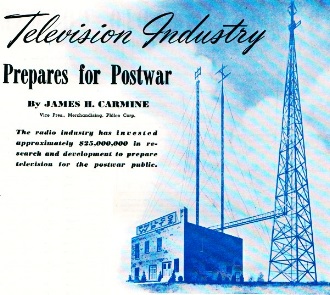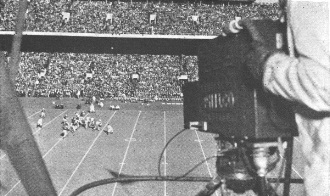|
Philco began selling
radios in 1928 after originally being a storage battery manufacturer. Their first
television, the Predicta, was
introduced in 1957. That was more than a decade after Philco Corporation's James
Carmine wrote this article discussing how the American buying public
(aka consumers) might embrace the concept of TVs in
their homes. Many people at the time had no interest in television both due to the
expected cost and the relatively poor performance of existing examples. If you
have ever seen pictures of early TVs, they typically had very small displays and
poor picture quality (obvious scan lines, low contrast, picture distortion, etc.).
As with almost all forms of consumer electronics, production and sales of new television
sets was put off during World War II so that precious components and materials
would be available for the war effort. Once the war ended in 1945, all industries
were unleashed and a flood of surplus items, from electronics to mechanics to clothing,
hit the distribution markets providing virtually limitless access to designers and
resale distributors at prices far below retail. Magazines in the late 1940s were
chock full of full-page advertisings plugging government surplus stock.
Television Industry Prepares for Postwar

Philco Television Station, WPTZ, Philadelphia. Shown from left to right are the
ultra-high-frequency relay receiving antenna; the New York sound receiving antenna;
and the main WPTZ picture and sound transmitting antenna.
By James H. Carmine
Vice Pres., Merchandising, Philco Corp.
The radio industry has invested approximately $25,000,000 in research and development
to prepare television for the postwar public.
Probably never before has the product of a great new industry been so completely
planned and so highly developed before it was offered to the public as has television.
The best evidence that the public thinks well of television is the universal response
that comes from those who have a chance to see it. As soon as television receivers
can be made and sold, the public most likely will eagerly buy them in tremendous
quantities.
A recent consumer survey revealed that 86% of the people would like to have a
television receiver in their homes. Few, if any, postwar wants are more general.
Because it is a highly technical scientific instrument, a television receiver,
to operate properly, must be installed by skilled personnel and serviced by those
who are especially trained in this work. Here again television will start off with
a great advantage over automobiles, radios, and all our modern household appliances
in that a large body of experienced personnel, who have had the benefit of Army
and Navy radio and high-frequency training, will be ready to handle installation
and service as soon as the war is over. It is estimated that the number of these
experienced servicemen, who can be given the latest television information very
quickly, is close to 20,000. Their availability and desire to get into television
will give a tremendous stimulus to the video art.
Over and above its postwar employment opportunities, television will make great
contributions to the public welfare in the fields of education and entertainment.
By combining sight with sound, television is the ideal medium for the transmittal
of ideas and intelligence. It is the next best thing to talking with a teacher face-to-face.

Station WPTZ picks up a football game at Franklin Field. Philadelphia. Philco
has been televising these games for the past five consecutive years.
Properly used, television can do much to make the people of the United States
better informed and better educated than ever before. In the entertainment field,
it opens whole new vistas which courageous pioneers are now spending time and money
to explore and develop in anticipation of the day when television stations will
cover the whole country and a tremendous audience will exist.
Present television broadcasting would be within the reach of about 25,000,000
persons if receivers were available. If all the stations for which permits have
been requested are constructed, television coverage would expand to 70,000,000 people
- more than half the population of the country. The New York-Philadelphia relay
link sets a pattern whereby the stations in different cities can be tied together
to begin a national hookup and make the outstanding shows and news events of the
country available to the television audience.
As many people already know, television is now becoming international, and construction
of a transmitter in Mexico City is being considered.
In popularizing television and giving it the initial impetus it needs to get
underway, the most important thing is to let people see it for themselves. Television
itself is many times more powerful than any words that can be said about it. Even
today, only an infinitesimal number of people in the whole United States have seen
television. What the industry need, to do, as quickly as possible, is to give demonstrations
all over the United States. If this is done, such questions as demand, price, production,
and markets will almost solve themselves. The public response will surprise everyone
in its enthusiasm and spontaneity.
Color and Monochrome (B&W) Television
Articles
Posted June 22, 2023
(updated from original post
on 10/15/2014)
|











